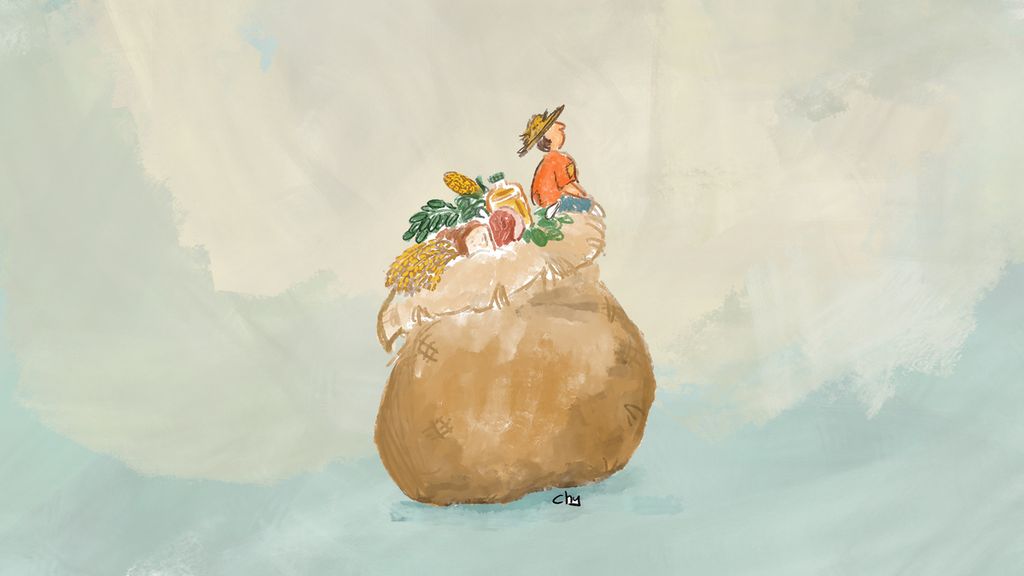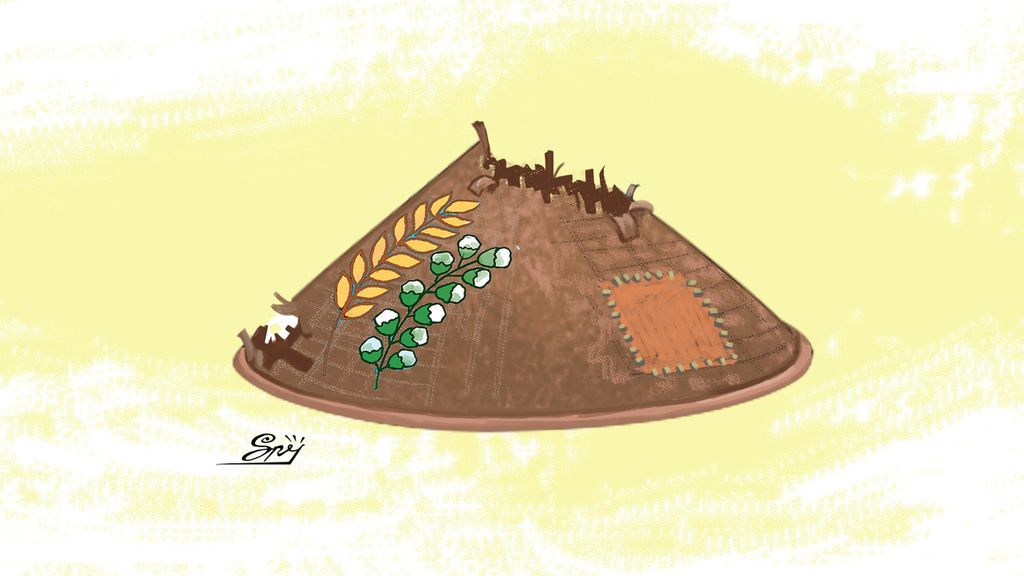Social Capital Deficit in ‘Food Estate’
Farmers' welfare should be the foundation for agricultural sustainability in supporting the national food production.

The Indonesian government has and is currently launching a national food security program called the food estate or food barn.
Just like the problem of the world in providing food today, even though technology regarding food development continues to develop, this program cannot rule out the need for extensive land.
Wide-scale agricultural practices are always based on farmer culture and various forms of collective action or social capital attached to it.
Rice planting has been done since 3,000 years before the common era. Evidence of thousands of years of rice cultivation is found in Sulawesi and rice has become our staple food. Jean Gelman Taylor mentioned this in his book, Indonesia: Peoples and Histories.
In addition to planting rice, the Indonesian people in the past also planted coconut, sugar palm, tuber, taro, shallot and tropical fruit. This means learning and practicing agriculture is not only learning knowledge that is developed into agricultural projects, but also learning the life of farmers and their environment.
Also read:
> Disorder in Central Kalimantan Food Estate
If we see farmers in the field, it is as if they and the land have become one. From morning to evening, farmers are busy with the land and plantations so that the yields can be maximized. Socially, they consist of farmers with different positions as land owners, land tenants, cultivators or farm laborers. They have kinship relations, business ties or workers and employers that form relatively permanent social capital.
This fact cannot be reduced to merely producing food because farming is essentially caring for life by cultivating the land and glorifying diversity. They work to maintain the ecosystem so that the agricultural land can remain relatively fertile. There is a culture that harmonizes nature through taste, initiative and work in the cultivation of cultural farmers. The culture created and lived by farmers is a culture based on cultivating the land (Joko Yuliyanto, 2021).
In the Javanese language, the farmer's personality is referred to as uthek (keep working), ulet (tenacity) and ubet (finding a solution).
Farmers have a habit of working from dawn to sunset. If there are rats, they are willing to go down to the fields at night to keep guard and chase them away. This activity is called ulet for always trying its best to get abundant harvests. It is also called ubet because it can deal with climate change conditions or pests, which can be interpreted and become local knowledge for the next generations.

Weaknesses of ‘food estates’
The construction of a food barn is defined as a large-scale food business by utilizing capital, technology and other resources to produce food products in order to meet human needs in an integrated manner including food crops, horticulture, plantation, livestock and fisheries in a forest area.
With the definition contained in the the Environment and Forestry Ministry Regulation No. 7/2021, the food estate program is assumed to be able to work based on the relationship between investment, technology, capital, labor and market, as is the case with the manufacturing industry in general.
All factors of production are deemed unnecessary to have a historical relationship with the farmer who works on them. This means that the food estate program is trying to break away from cultural agriculture by embracing a project approach to building its facilities and infrastructure. In this way, if we learn from food estate operations that have been running, we can gain the following knowledge.
Also read:
> The Collapse of the Dayak Kalimantan Food Barn
> Disorder in Central Kalimantan Food Estate
The first is low yields. In Merauke, Papua, for example, out of the allocated area of 1.23 million hectares that was cleared in 2011, only 400 hectares are still running, left by PT Parama Pangan Papua in partnership with local farmers. In Ketapang, West Kalimantan in 2013, from a potential land area of 886,959 hectares, the regency administration was able to cultivate 100,000 ha. After two years of operation, there is only 104 ha of food estate that can be processed.
In Bulungan, East Kalimantan, in 2011, from a food estate area of 298,221 ha, only 1,024 ha of land turned into paddy fields and only 5 ha of land produced crops. For the peatland project in Central Kalimantan in 1996, out of an area of 1.5 million ha, around 48,000 ha of the area was cleared.
Second, the loss of subject position. From several observations, the results of the food estate were low because the project manager did not place the local community as a subject.
The orientation of the project toward production led to the adherence to only technical measures as the basis for determining success, such as the area of food estate, the amount of investment, working capital and production facilities. As a result, the implementation of development is not adapted to the agricultural culture or the character of the local ecosystem.
From several observations, the results of the food estate were low because the project manager did not place the local community as a subject.
The practice of eliminating subjects in the project also eliminates social capital, local wisdom and the fundamental values of cultural agriculture. In practice, when the pretext of agricultural modernization is proclaimed in the food estate, it has been proven that there are no key factors that can change the personality of this cultural agriculture.
Eliminating the subject's position is also carried out by ignoring natural resources (SDA) which are the mainstay of food sources for local communities. In the case of Marind-Anim Merauke, Papua, for example, the conversion of forests which were considered an unproductive resource, into food estate, triggered a shift in food patterns, which caused nutrition and health problems for the local community (Kompas, 13/12/2022 ).

Third, the project-approach problem. When food storage is considered as goods that can be prepared, an administrative approach is more prominent than a functional approach, which depends on the conditions in the field. This is at the same time a major weakness in the construction of a food estate that buildings and physical goods are considered results. In fact, agriculture can stand on its own in the long term as a result of being supported by social capital.
For the case in Papua, namely in Bokem village, Merauke, most of the former paddy fields in 2018 were abandoned. Likewise, in the village of Marind Anim, Animba district, the opening of rice fields in 2010 was declared a failure and turned into reeds (Kompas, 14/12/2022). This was generally because the orientation was not the final result, but was limited to procurement and was considered complete.
This fact is in contrast, for example, in the implementation of social forestry, which prioritizes community strengthening as the subject of development. The key factor needed here is community assistants to strengthen social capital as a first step in order to be able to manage the various potentials of the natural resources they face. Of the 103 social forestry business groups surveyed, 96 percent said having a companion was a determining factor for success (KataData, 2020).
Also read:
> Rice Surplus, Adequacy and Reserves
> World Food and Indonesia 2023
Apart from weaknesses, goods procurement and construction projects are also prone to corruption, bribery or fraud. The study that is currently underway on basic data on agricultural corruption by the IPB and the Corruption Eradication Commission shows that most agricultural corruption is carried out in infrastructure procurement and development activities.
There are five stages in procurement that are prone to corruption, namely in budget planning, the preparation of procurement, the implementation of procurement, the handover of work and payment, as well as supervision and accountability.
The electronic procurement system limits public official meetings with third parties in the procurement technocratic process. Apart from that, in principle, public officials and third parties cannot be prevented from meeting or making any agreements.
Structural and governance problems
The three food estate problems that have occurred indicate that there are structural and governance issues that hinder the project's objectives. Instead of being able to create food security, the project can actually create opportunities for failure or corruption. For this reason, in order for this program to be fit for purpose, the manager needs to develop the social capital of farmers first, including settling claims on land rights and forest areas before the project starts.
This is because farmers are the main subject of the food estate construction. Farmers' welfare should be the foundation for agricultural sustainability in supporting the national food production.

Hariadi Kartodihardjo
Hariadi Kartodihardjo
Professor at the Faculty of Forestry and Environment and Fellow at the Center for Transdisciplinary and Sustainability Sciences, IPB University
This article was translated by Kurniawan Siswo.